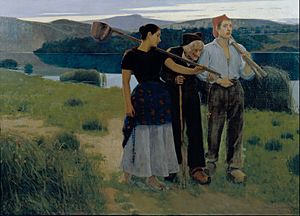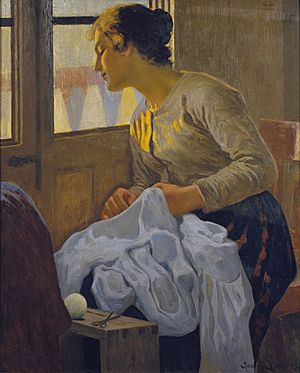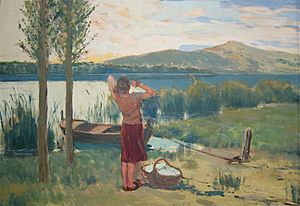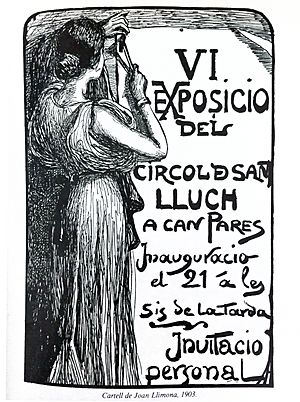Joan Llimona facts for kids
Quick facts for kids
Joan Llimona
|
|
|---|---|
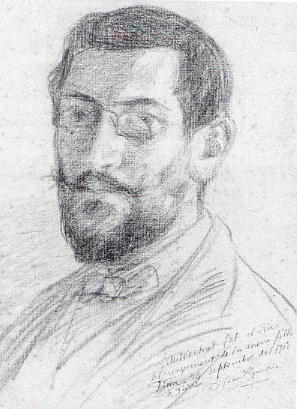
Self Portrait by Joan Llimona, 1903
|
|
| Born |
Joan Llimona i Bruguera
23 June 1860 Barcelona, Catalunya, Spain
|
| Died | 23 February 1926 Barcelona, Catalunya, Spain
|
| Nationality | Spanish |
| Education | School of Llotja, Barcelona |
| Known for | Painter |
| Movement | Orientalist; Cercle Artístic de Sant Lluc; Modernist |
Joan Llimona i Bruguera (1860-1926) was a talented Spanish artist. He became well-known at the end of the Romantic movement in Europe. Llimona was also a very important part of the modernist movement in art.
He was born in Barcelona in 1860 and passed away in his hometown in 1926. Even though he lived for a shorter time, Llimona left a big mark on European art. His work helped shape the modernist style in the early 1900s. Religion deeply influenced Llimona. Many of his paintings show religious scenes and share religious messages.
Contents
Early Life and Family
Joan Llimona was born in Barcelona, Spain, on June 23, 1860. He grew up in a family that was both very religious and artistic. Joan was especially close to his brother, Josep Llimona. Josep became a famous modernist sculptor.
Joan Llimona also had two children who became important artists. His daughter Nuria Llimona Raymer was a painter. His other daughter, Mercedes Llimona Raymer, became an illustrator. Joan Llimona died in Barcelona in 1926.
Education and Artistic Growth
Before Joan Llimona became a well-known artist, he first studied architecture and engineering. However, he soon discovered his love for painting. Llimona then decided to leave his architecture studies. He chose instead to study painting at the School of Llotja in Barcelona.
Llimona also spent a lot of time studying painting in different European cities. He focused his studies mainly in Madrid and Venice. During his frequent trips to Madrid, Llimona spent hours at the Prado Museum. There, he carefully studied the paintings of famous artists.
In 1882, Llimona traveled to Venice to improve his painting skills. He wanted to make his paintings brighter and use colors better. He felt his earlier works were sometimes too plain. To practice, Llimona painted outdoors. He also visited many museums in Venice. He studied paintings by Veronese, Tiepolo, and Tintoretto.
Trip to Rome
After his painting studies, Llimona went to Rome with his brother. Josep had won a scholarship to study Roman sculpture there. When they arrived, the brothers were welcomed into a workshop. They rented a studio in the Villa Estrollfern. This villa was near the Villa Borghese. This studio became Llimona's home and workspace in Rome. During the day, Llimona worked in his studio. At night, he attended the Academy of Gigi.
In Rome, Llimona explored his artistic interests. He also worked on making his painting techniques perfect. He and his brother made strong friendships with other artists. Some were from Catalonia, and others were from different places. One important friend Llimona made was Joan Carles Martí Priozzini. Letters between them show how determined Llimona was to succeed as a painter.
At that time in Rome, two main art styles were popular. One was historical paintings. The other was Neapolitan depictions. After his time in Rome, Llimona combined these styles with his modernist ideas in many of his works.
Return to Barcelona
When Joan Llimona returned to Barcelona, he was 24 years old. At that time, there were two main groups of artists in the city. One group was more upper-class and met at the Barcelona Athenaeum. The other group was more focused on craftspeople. They formed the Center Watercolourists in Cathedral Square.
Llimona joined the second group. He spent his time painting with many different people from Spanish society. In Cathedral Square, artists like Llimona would paint models. They also enjoyed playing dominoes together.
In this early part of his career, many of Llimona's paintings were very detailed. They showed everyday scenes with dramatic backgrounds. In December 1884, Llimona took part in the Second Exhibition of Fine Arts. He showed his work alongside other famous artists.
In 1886, he showed his painting "At dawn" at the Paris Salon exhibition. In 1887, he presented his painting "Migrants" at the fine arts exhibition. These paintings, along with "The first tooth" from 1889, are good examples of Joan Llimona's early work.
Artistic Styles and Development
After 1905, Llimona's paintings clearly showed the influence of symbolism. Also, after he became a Catholic in 1890, his art kept its strong religious themes.
Later in his career, Llimona joined a group called the "Lliga del Bon Mot." This name means "League of Good Word." The group aimed to protect traditional ideas of morality.
Llimona and his brother also helped start the "Cercle Artístic de Sant Lluc." This was a place for sharing traditional Catholic morals through art. This society is still active today.
Religion's Influence
Even though Llimona fully committed to Catholicism in 1890, religion always had a deep impact on his life and art. In 1890, Joan Llimona became a devoted Catholic. He was thirty years old at the time. Many people think his conversion helped him find direction in his life.
Some connect this change to Llimona's trip to Rome. There, he became ill and was treated by Dr. Josep Blanch Benedict. Dr. Benedict was a very religious man. He talked to Joan about finding spiritual peace through the Church. Llimona's strong faith led him to believe in putting faith into action. He believed in doing good deeds and helping those he saw as vulnerable.
Soon, Catholicism filled his art. Some of his works caused strong reactions. For example, "The Sudden Death" was criticized. Llimona later decided to destroy it. He even used the canvas to paint another work in 1896. In this period, his earlier detailed style mixed with his desire to show feelings and inspire kindness.
Artistic Circle of St. Luke
In 1893, the Llimona brothers, along with other famous artists like Antonio Gaudí, started the Artistic Circle of St Luke. This group wanted to bring Christian artists together. They aimed to create an artistic community. The group's values were based on strong Catholic beliefs. They explored how religion and morality connected in art.
Notable Works
- "Autorretrato" (Self-portrait) 1903
- "San Felipe Neri en la consagración de la Santa Misa" (Saint Philip Neri at the Consecration of Holy Mass) 1902; found in the Church of San Felipe Neri, Barcelona
- "Cartell Circol S Lluc" (Poster for St. Luke's Circle)
- "V Exposición Internacional de Arte" (5th International Art Exhibition) 1907
- "Apunte" (Sketch) 1917
- "El enfermo" (The Sick Man)
- "Dona estesa" (Woman Stretched Out) 1902
- "La esposa" (The Wife)
- "Dalt del terrat" (On the Rooftop)
- "Noia llegint" (Girl Reading) 1900-1905
- "Pensativa junto al río" (Thoughtful by the River) 1920
- "La carta" (The Letter) 1905
- "Lectura" (Reading) 1891
- "Mujer melancólica" (Melancholy Woman) 1910
- "Noia estirant-se (Chica estirándose)" (Girl Stretching) 1916
- "L'ultima Pasqua" (The Last Easter)
- "Azul (chica en paisaje)" (Blue (Girl in Landscape))
- "Costa Tramontana mallorquina" (Tramontana Coast of Mallorca)
- "Cristo yacente" (Recumbent Christ); a copy of a sculpture by his brother, Josep Llimona, located in the Cathedral of Barcelona
- "San José con Jesús" (Saint Joseph with Jesus) 1920
- "Virgen con Niño" (Virgin with Child) 1920
- "San Felipe Neri and la consagración de la Santa Misa" (Saint Philip Neri and the Consecration of Holy Mass) 1902
- "Tornant del tros" (Returning from the Plot) 1896
- "La muerte súbita antes de ser repintada" (The Sudden Death before being Repainted)
See also
 In Spanish: Joan Llimona para niños
In Spanish: Joan Llimona para niños
- List of Orientalist artists
- Orientalism


